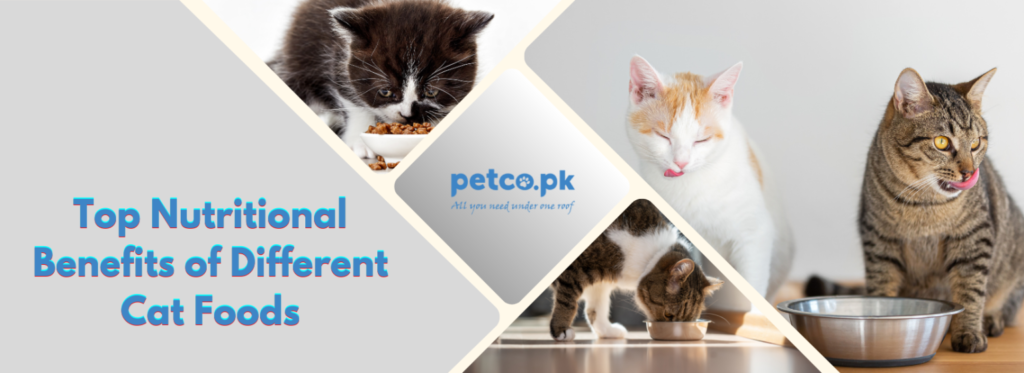One of the best ways to keep cats healthy and happy is to feed them well. Cats need all the right nutrients in just the right proportions to grow, maintain their bodies, be active, and prevent and recover from illness or injury. Nutrients are components of the diet that perform specific jobs in the body. Cats can get the nutrients they need from a variety of ingredients. For example, calcium (a nutrient) can come from ingredients like bone, bone meal, dairy products, organ tissues, meat, legume plants, and a mineral supplement. Energy is not technically a nutrient, but it is still an important part of a cat’s diet. Dietary energy, measured in kilocalories (calories), comes from fats, proteins, and carbohydrates. Cats are carnivores and need to eat a lot of protein compared to many other animals. Dietary protein is used to develop and maintain muscle, skin, fur, nails, tendons, ligaments, cartilage, enzymes, hormones, antibodies, and more.
In cats, protein is also an important source of energy. Cats need animal protein because their bodies need the nutrients it provides. When a cat eats protein, their digestive tract breaks it down into building blocks called amino acids, which are then reassembled into the type of protein that the cat needs at that time. These essential amino acids, as well as other essential nutrients for cats, are best supplied by meat and other animal tissues, which makes sense when you think about it.
What Does Crude Protein Mean?
Protein, especially animal protein, is expensive. Some cat food manufacturers keep costs low by including only the minimum amount of protein that cats require to survive, not more to help them thrive. A cat food’s crude protein level should be included in the guaranteed analysis section on the label. Crude protein is an estimate of a diet’s protein level that is determined by measuring the amount of nitrogen present. By looking at crude protein levels, you can compare how much protein different cat foods contain. However, you’ll need to do some calculations to compare a dry food to a wet food. You’ll also need to do some simple math to see whether a cat food meets or exceeds the amount of protein a cat needs.
Can Cats Be Allergic to Certain Proteins?
Protein can be problematic; too much protein, particularly low-quality protein, can worsen symptoms associated with kidney disease in cats. Proteins are also the primary trigger for food allergies in cats. If your cat has health problems, be sure to discuss what type of cat food would be best with your veterinarian.
Fats in Cat Food
While proteins are an important energy source for cats, fat is the most energy-rich nutrient in the diet. Fats also act as transport molecules, and they help conduct nerve impulses. Essential omega-3 and omega-6 fatty acids are also important for skin and coat health, wound healing, and inflammation.
Nutritional Benefits
Supports Healthy, Shiny Fur
Essential amino and fatty acids are an important part of your cat’s overall health as well as keeping their fur shiny and thick. Specifically, antioxidants, omega-3 fatty acids, linoleic acid, and zinc can help increase the glossiness in your kitty’s coat, and decrease dry, flaky skin. These ingredients and more are present in The Honest Kitchen’s cat foods, as well as the specific amino acid, taurine, which is vital to cats’ health.
Encourages a Healthy Gut
Gut bacteria is the way your cat digests their food, and the type of food you feed them will influence which bacteria thrive and which will die. Many fillers found in traditional cat foods can upset a cat’s microbiome, leading to stomach upset and poor digestion. Even more, cats are obligate carnivores so feeding a cat a high-protein, low-carb diet will help their overall digestive health because it aligns with their biology. Some pet owners go as far as feeding their feline friends a raw meat diet. While this is the closest thing to what they’d get in the wild, it’s not the most affordable or sustainable option. If you’re looking for a more convenient solution, The Honest Kitchen creates cat food ideal for maintaining your cat’s healthy gut, with protein making up 40% or more of the calorie distribution and carbs making up a small percentage of overall calories per serving.
Offers High-Quality Protein
Did you know that pet foods that are not human grade certified are often made using 4D meats? This is meat from animals who were either dead, dying, diseased, or disabled. These types of animal proteins are drastically different in quality from meat that is safe for human consumption. The quality level of meat also affects the type of protein it contains, which ties directly to your cat’s health. For an energetic cat, you’ll want to feed them the highest-quality protein you can find, such as ranch-raised beef and cage-free chicken.
Helps Your Feline Maintain a Healthy Weight
For many cats, weight can be an issue especially those who are city dwellers and may not have as much space to run around. In fact, according to a study by Cornell University, 10% of cats today are considered overweight, and 40% are obese. Because of this, finding cat food with high-quality ingredients is very important. Even if there are some grains and carbohydrates in your cat’s food, you’ll want to be sure they are quality foods (such as sweet potato), and considered to be whole foods. Ingredients that are whole foods are typically not heavily processed. Highly processed foods like in humans can be detrimental to your cat’s health.
Conclusion
Whether you have a senior cat or a cat in a younger life stage, making the switch to the best human-grade pet food can seem like a challenge. Cats are known to be picky eaters and have sensitive stomachs. However, taking the time to make the change to human-grade cat food can have numerous positive effects on your cat’s overall health. To help aid you in the process, Petco. pk is here to guide you and offer products with one click away through its website.



